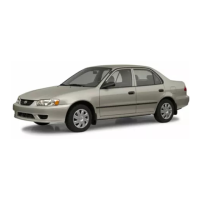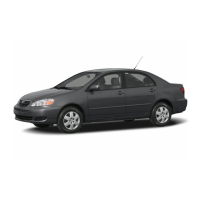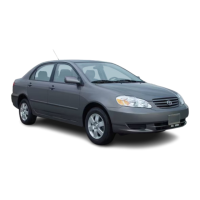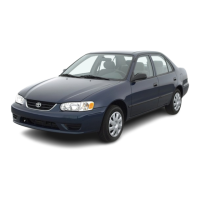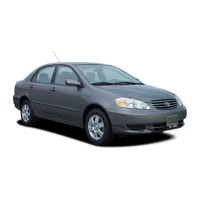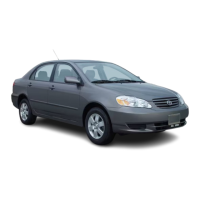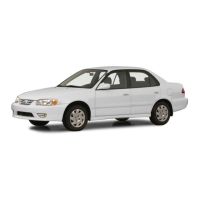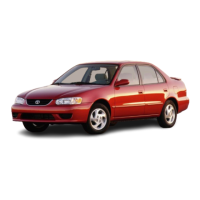Do you have a question about the Toyota Corolla 2007 and is the answer not in the manual?
Details the various components of the instrument panel.
Explains the instrument cluster for Type A vehicles.
Lists and explains various indicator symbols found on the instrument panel.
Explains the master and sub keys, their functions, and care.
Explains the theft prevention system and how it functions.
Details the operation and precautions for the wireless remote control system.
Explains how to lock and unlock the vehicle doors using the remote.
Describes how to activate the panic mode for the alarm system.
Provides instructions for replacing the battery in the wireless remote transmitter.
Covers manual and power locking/unlocking of side doors.
Explains how to lock and unlock doors using the interior lock knob.
Describes how to lock and unlock doors using the power door lock switch.
Explains the function and use of rear door child-protector locks.
Details various modes for automatic door locking and unlocking.
Provides steps to change the automatic door locking/unlocking mode.
Explains the operation and safety precautions for the power windows.
Covers how to open and close the trunk lid and related safety precautions.
Explains how to use the lock release lever to open the trunk lid.
Describes how to deactivate the lock release lever.
Explains the function of the internal trunk release handle.
Details the theft deterrent system, its setting, and activation.
Explains how to open the vehicle's hood and related safety precautions.
Covers the operation and precautions for the fuel tank cap.
Explains the operation of the electric moon roof, including sliding and tilting.
Discusses proper seating positions and adjustments for safety.
Specific safety precautions for the front passenger seat and airbags.
Precautions related to side airbags installed in front seats.
General precautions to follow when adjusting vehicle seats for safety.
Step-by-step guide on how to adjust front seats for position, height, and angle.
Instructions on how to fold down the rear seat and related precautions.
Guidance on adjusting head restraints for optimal safety and comfort.
Comprehensive guidance on the proper use and precautions for seat belts.
Details essential precautions for using seat belts correctly and safely.
Step-by-step instructions on how to fasten seat belts properly.
Explains how to adjust the shoulder anchor position for seat belts.
Information on using a seat belt extender and its precautions.
Describes the function and activation of seat belt pretensioners.
Explains the driver and front passenger airbag systems and their operation.
Provides guidance on child restraint systems, their installation, and precautions.
Describes the types of child restraint systems and their proper usage.
Classifies child restraint systems into three types: infant, convertible, and booster seats.
Provides instructions for installing child restraint systems using the vehicle's seat belts.
Instructions for installing a convertible child seat, considering forward or rear-facing positions.
Explains the front passenger occupant classification system and its indicator light.
Instructions on how to adjust the steering wheel's angle.
Guidance on adjusting the outside rear view mirrors for optimal visibility.
Explains how to adjust power-operated rear view mirrors.
Describes the manual anti-glare adjustment for the inside rear view mirror.
Explains the automatic anti-glare function of the inside rear view mirror.
Instructions on how to use the vanity mirrors located in the sun visors.
Details how to operate headlights and turn signals, including daytime running lights.
Explains the function and operation of emergency flashers.
Instructions on how to turn on and use the front fog lights.
Explains how to adjust the brightness of the instrument panel lights.
Describes the operation of the interior light with its different modes.
Explains how to operate personal lights and the automatic light cut-off system.
Details the operation of windshield wipers and washer fluid.
Explains how to operate the rear window defogger and its automatic shut-off feature.
Explains how to read the fuel gauge and the low fuel level warning light.
Details how to read the engine coolant temperature gauge and what to do if the engine overheats.
Explains the function of the tachometer for monitoring engine speed.
Describes how to read the odometer and use the trip meters.
Explains how to read the outside temperature display and potential display issues.
Lists and explains various service reminder indicators and warning buzzers.
Explains the different positions of the ignition switch and related precautions.
Details the operation of the automatic transmission, including the shift lock system.
Covers the operation of the manual transmission, including shifting and clutch use.
Explains the function and operation of the traction control system.
Explains the warning light for the Vehicle Stability Control system.
Explains the tire pressure warning system, its function, and how to initialize it.
Covers the operation of the parking brake and its reminder light.
Explains how to operate the cruise control system, including setting and cancelling speed.
Introduces the basic features of the Toyota audio systems.
Explains essential functions like turning the system on/off and switching between modes.
Details specific buttons, controls, and features of the audio system (Type 1).
Details specific buttons, controls, and features of the audio system (Type 2).
Identifies and explains the controls for the air conditioning system.
Explains how to adjust fan speed.
Explains how to adjust the vehicle's interior temperature.
Details the different air flow modes and their functions, including defogging.
Explains the function and indicator of the A/C button.
Describes how to select the air intake source (recirculate or fresh).
Provides details on various air flow selector settings and their effects.
Offers practical tips for using the air conditioning system effectively in different conditions.
Explains how to adjust side vents for air flow control.
Information on the air conditioning filter, its location, and function.
Instructions on how to set and reset the vehicle clock.
Explains the use of the cigarette lighter and the portable ashtray.
Details the use and precautions for the vehicle's power outlets.
Explains how to read the compass, its operating conditions, and calibration.
Explains the circling calibration method to adjust compass direction.
Instructions on how to open and close the glove box door.
Details the use of auxiliary boxes and associated safety precautions.
Explains how to access the rear console box and its upper tray.
Information on the design and use of cup holders, including safety precautions.
Guidance on selecting and installing the correct floor mats for safety.
Guidance on the recommended break-in procedure for a new vehicle.
Information on fuel type, octane rating, and fuel tank capacity.
Explains the fuel pump shut-off system's function in collision scenarios.
Advice for driving a Toyota in other countries, focusing on fuel availability.
Explains the function of the catalytic converter and precautions to prevent damage.
Important safety precautions regarding engine exhaust fumes.
Explains normal engine oil consumption and factors influencing it.
Information about the iridium-tipped spark plugs and their maintenance.
Covers the hydraulic brake system, brake booster, and anti-lock brake system.
Explains the brake pad wear indicators and when to replace brake pads.
Details the VIN, its legal identifier status, and where it can be found.
Information on theft prevention labels and why they should not be removed.
Precautions regarding modifications to the suspension or chassis.
Illustrates and explains the various symbols found on a standard tire sidewall.
Details total load capacity, seating capacity, towing capacity, and cargo capacity.
Important precautions for stowing cargo and luggage safely and securely.
Explains how to calculate and distribute cargo and luggage capacity.
Describes different types of tires (summer, all-season) and their characteristics.
Outlines essential checks and adjustments to perform before starting the engine.
Provides instructions for starting the engine, including normal starting and flooded engine procedures.
Offers advice for driving safely in different weather and road conditions.
Provides specific tips for driving safely in winter conditions.
Explains the process and precautions for dinghy towing a vehicle.
Comprehensive guide to towing trailers, including weight limits and precautions.
Provides tips for improving fuel economy and extending vehicle lifespan.
Troubleshooting steps for when the vehicle's engine will not start.
Steps to take if the engine stalls while the vehicle is in motion.
Troubleshooting tips for situations where engine speed cannot be increased.
Procedure to follow if the engine coolant temperature indicates overheating.
Step-by-step instructions for changing a flat tire.
Information on the compact spare tire, its use, and limitations.
Lists the tools and spare tire needed for changing a flat tire.
Explains how to block wheels for safety when jacking up the vehicle.
Instructions on how to remove wheel ornaments from steel wheels.
Guidance on how to loosen wheel nuts before raising the vehicle.
Instructions on correctly positioning the jack for lifting the vehicle.
Instructions on how to safely raise the vehicle using the jack.
Steps for removing wheel nuts and changing tires.
Instructions on how to properly reinstall and tighten wheel nuts.
Instructions on how to safely lower the vehicle after changing a wheel.
Advice on how to free a vehicle that is stuck in snow, mud, or sand.
Information on how to have a vehicle towed, including different towing methods.
Details on towing with a wheel lift truck, from front and rear.
Guidance on using a flat bed truck for towing.
Explains towing with a sling type truck, with precautions.
Instructions for emergency towing using a cable or chain if professional service is unavailable.
Troubleshooting steps if the transmission selector lever cannot be moved from 'P'.
What to do if you lose your vehicle keys and how to obtain replacements.
Steps to take if you lose the wireless remote control transmitter.
Provides detailed advice on how to prevent corrosion on the vehicle, especially the underside.
Instructions on how to wash the vehicle to maintain its paint and body.
Guidance on hand-washing the vehicle to avoid paint damage.
Advice on using automatic car washes and potential risks to paint.
Recommends waxing the vehicle to maintain its finish and provides instructions.
Instructions for cleaning the vehicle's interior, including vinyl upholstery and carpets.
How to clean and care for vinyl upholstery.
Instructions on how to clean vehicle carpets.
Guidance on cleaning seat belts and checking for wear.
How to clean vehicle windows.
Instructions for cleaning various interior panels, buttons, and switches.
How to clean and care for leather upholstery.
Explains the importance of regular maintenance and owner's responsibility.
Lists day-to-day care practices important for proper vehicle operation.
How to check and add washer fluid for the windshield.
Specifies checks to be performed in the engine compartment.
Checks for the exhaust system and cautions regarding fumes.
Lists items to check inside the vehicle regularly.
Checks for proper operation of headlights, taillights, and other lights.
Checks for proper function of service indicators and buzzers.
Alerts for changes in steering condition or noises.
Checks for proper operation of seat controls, latches, and head restraints.
Checks seat belt system for proper operation and wear.
Checks pedal for smooth operation and effort.
Checks clutch pedal for smooth operation.
Checks brake pedal operation, clearance, and booster function.
Checks if brakes pull to one side when applied.
Checks parking brake travel and holding ability on an incline.
Checks the lock release button and 'P' position security.
Lists items to check outside the vehicle periodically.
Checks for fuel, oil, water, or other fluid leaks.
Lists common clues that indicate a vehicle may need service or repair.
Explains vehicle emission inspection programs and the role of the malfunction indicator lamp.
Provides a diagram and labels for the main components in the engine compartment.
Shows the locations of the fuse boxes in the vehicle.
General precautions to follow when performing DIY maintenance to prevent injury or warranty issues.
Instructions on correctly positioning the jack for lifting the vehicle.
Lists the parts and tools needed for common do-it-yourself maintenance tasks.
Instructions on how to check the engine oil level using the dipstick.
Guidance on selecting the correct engine oil grade and viscosity.
Instructions for checking the engine coolant level and selecting the correct coolant type.
Guidance on checking the radiator and condenser for cleanliness.
Instructions on how to check the brake fluid level.
Instructions on how to check the power steering fluid level.
Details on how to check tire inflation pressure and related precautions.
Explains how to check tire tread wear and when to replace tires.
Recommends tire rotation for even wear and extended tire life, and provides guidance.
Information on when to use snow tires/chains and how to install them.
Guidelines for replacing tires, including size, load capacity, and balancing.
Precautions when installing or using aluminum wheels.
Instructions on how to check the battery's condition and its exterior.
Important safety precautions related to the vehicle battery.
Emergency procedures for handling battery electrolyte exposure.
How to check the battery for corrosion or loose connections.
How to check battery condition using the indicator color.
Safety precautions to follow when recharging the vehicle battery.
Instructions on how to check, identify, and replace blown fuses.
Details on how to check and add washer fluid, including recommendations for cold weather.
Instructions for accessing and replacing various exterior and interior light bulbs.
Step-by-step instructions for replacing headlight bulbs.
Instructions for replacing parking, side marker, and turn signal bulbs.
Instructions for replacing front fog light bulbs.
Instructions for replacing rear marker, stop/tail, and turn signal bulbs.
Instructions for replacing back-up light bulbs.
Instructions for replacing the high-mounted stoplight.
Notice regarding replacing license plate light bulbs.
Lists the overall dimensions and weight specifications of the vehicle.
Provides details about the vehicle's engine model, type, bore, stroke, and displacement.
Details fuel type, octane rating, and fuel tank capacity.
Lists various service specifications for engine components and lubrication.
Information on tire sizes, cold inflation pressures, and wheel nut torque.
A diagram showing fuse locations in the engine compartment.
Details the various components of the instrument panel.
Explains the instrument cluster for Type A vehicles.
Lists and explains various indicator symbols found on the instrument panel.
Explains the master and sub keys, their functions, and care.
Explains the theft prevention system and how it functions.
Details the operation and precautions for the wireless remote control system.
Explains how to lock and unlock the vehicle doors using the remote.
Describes how to activate the panic mode for the alarm system.
Provides instructions for replacing the battery in the wireless remote transmitter.
Covers manual and power locking/unlocking of side doors.
Explains how to lock and unlock doors using the interior lock knob.
Describes how to lock and unlock doors using the power door lock switch.
Explains the function and use of rear door child-protector locks.
Details various modes for automatic door locking and unlocking.
Provides steps to change the automatic door locking/unlocking mode.
Explains the operation and safety precautions for the power windows.
Covers how to open and close the trunk lid and related safety precautions.
Explains how to use the lock release lever to open the trunk lid.
Describes how to deactivate the lock release lever.
Explains the function of the internal trunk release handle.
Details the theft deterrent system, its setting, and activation.
Explains how to open the vehicle's hood and related safety precautions.
Covers the operation and precautions for the fuel tank cap.
Explains the operation of the electric moon roof, including sliding and tilting.
Discusses proper seating positions and adjustments for safety.
Specific safety precautions for the front passenger seat and airbags.
Precautions related to side airbags installed in front seats.
General precautions to follow when adjusting vehicle seats for safety.
Step-by-step guide on how to adjust front seats for position, height, and angle.
Instructions on how to fold down the rear seat and related precautions.
Guidance on adjusting head restraints for optimal safety and comfort.
Comprehensive guidance on the proper use and precautions for seat belts.
Details essential precautions for using seat belts correctly and safely.
Step-by-step instructions on how to fasten seat belts properly.
Explains how to adjust the shoulder anchor position for seat belts.
Information on using a seat belt extender and its precautions.
Describes the function and activation of seat belt pretensioners.
Explains the driver and front passenger airbag systems and their operation.
Provides guidance on child restraint systems, their installation, and precautions.
Describes the types of child restraint systems and their proper usage.
Classifies child restraint systems into three types: infant, convertible, and booster seats.
Provides instructions for installing child restraint systems using the vehicle's seat belts.
Instructions for installing a convertible child seat, considering forward or rear-facing positions.
Explains the front passenger occupant classification system and its indicator light.
Instructions on how to adjust the steering wheel's angle.
Guidance on adjusting the outside rear view mirrors for optimal visibility.
Explains how to adjust power-operated rear view mirrors.
Describes the manual anti-glare adjustment for the inside rear view mirror.
Explains the automatic anti-glare function of the inside rear view mirror.
Instructions on how to use the vanity mirrors located in the sun visors.
Details how to operate headlights and turn signals, including daytime running lights.
Explains the function and operation of emergency flashers.
Instructions on how to turn on and use the front fog lights.
Explains how to adjust the brightness of the instrument panel lights.
Describes the operation of the interior light with its different modes.
Explains how to operate personal lights and the automatic light cut-off system.
Details the operation of windshield wipers and washer fluid.
Explains how to operate the rear window defogger and its automatic shut-off feature.
Explains how to read the fuel gauge and the low fuel level warning light.
Details how to read the engine coolant temperature gauge and what to do if the engine overheats.
Explains the function of the tachometer for monitoring engine speed.
Describes how to read the odometer and use the trip meters.
Explains how to read the outside temperature display and potential display issues.
Lists and explains various service reminder indicators and warning buzzers.
Explains the different positions of the ignition switch and related precautions.
Details the operation of the automatic transmission, including the shift lock system.
Covers the operation of the manual transmission, including shifting and clutch use.
Explains the function and operation of the traction control system.
Explains the warning light for the Vehicle Stability Control system.
Explains the tire pressure warning system, its function, and how to initialize it.
Covers the operation of the parking brake and its reminder light.
Explains how to operate the cruise control system, including setting and cancelling speed.
Introduces the basic features of the Toyota audio systems.
Explains essential functions like turning the system on/off and switching between modes.
Details specific buttons, controls, and features of the audio system (Type 1).
Details specific buttons, controls, and features of the audio system (Type 2).
Identifies and explains the controls for the air conditioning system.
Explains how to adjust fan speed.
Explains how to adjust the vehicle's interior temperature.
Details the different air flow modes and their functions, including defogging.
Explains the function and indicator of the A/C button.
Describes how to select the air intake source (recirculate or fresh).
Provides details on various air flow selector settings and their effects.
Offers practical tips for using the air conditioning system effectively in different conditions.
Explains how to adjust side vents for air flow control.
Information on the air conditioning filter, its location, and function.
Instructions on how to set and reset the vehicle clock.
Explains the use of the cigarette lighter and the portable ashtray.
Details the use and precautions for the vehicle's power outlets.
Explains how to read the compass, its operating conditions, and calibration.
Explains the circling calibration method to adjust compass direction.
Instructions on how to open and close the glove box door.
Details the use of auxiliary boxes and associated safety precautions.
Explains how to access the rear console box and its upper tray.
Information on the design and use of cup holders, including safety precautions.
Guidance on selecting and installing the correct floor mats for safety.
Guidance on the recommended break-in procedure for a new vehicle.
Information on fuel type, octane rating, and fuel tank capacity.
Explains the fuel pump shut-off system's function in collision scenarios.
Advice for driving a Toyota in other countries, focusing on fuel availability.
Explains the function of the catalytic converter and precautions to prevent damage.
Important safety precautions regarding engine exhaust fumes.
Explains normal engine oil consumption and factors influencing it.
Information about the iridium-tipped spark plugs and their maintenance.
Covers the hydraulic brake system, brake booster, and anti-lock brake system.
Explains the brake pad wear indicators and when to replace brake pads.
Details the VIN, its legal identifier status, and where it can be found.
Information on theft prevention labels and why they should not be removed.
Precautions regarding modifications to the suspension or chassis.
Illustrates and explains the various symbols found on a standard tire sidewall.
Details total load capacity, seating capacity, towing capacity, and cargo capacity.
Important precautions for stowing cargo and luggage safely and securely.
Explains how to calculate and distribute cargo and luggage capacity.
Describes different types of tires (summer, all-season) and their characteristics.
Outlines essential checks and adjustments to perform before starting the engine.
Provides instructions for starting the engine, including normal starting and flooded engine procedures.
Offers advice for driving safely in different weather and road conditions.
Provides specific tips for driving safely in winter conditions.
Explains the process and precautions for dinghy towing a vehicle.
Comprehensive guide to towing trailers, including weight limits and precautions.
Provides tips for improving fuel economy and extending vehicle lifespan.
Troubleshooting steps for when the vehicle's engine will not start.
Steps to take if the engine stalls while the vehicle is in motion.
Troubleshooting tips for situations where engine speed cannot be increased.
Procedure to follow if the engine coolant temperature indicates overheating.
Step-by-step instructions for changing a flat tire.
Information on the compact spare tire, its use, and limitations.
Lists the tools and spare tire needed for changing a flat tire.
Explains how to block wheels for safety when jacking up the vehicle.
Instructions on how to remove wheel ornaments from steel wheels.
Guidance on how to loosen wheel nuts before raising the vehicle.
Instructions on correctly positioning the jack for lifting the vehicle.
Instructions on how to safely raise the vehicle using the jack.
Steps for removing wheel nuts and changing tires.
Instructions on how to properly reinstall and tighten wheel nuts.
Instructions on how to safely lower the vehicle after changing a wheel.
Advice on how to free a vehicle that is stuck in snow, mud, or sand.
Information on how to have a vehicle towed, including different towing methods.
Details on towing with a wheel lift truck, from front and rear.
Guidance on using a flat bed truck for towing.
Explains towing with a sling type truck, with precautions.
Instructions for emergency towing using a cable or chain if professional service is unavailable.
Troubleshooting steps if the transmission selector lever cannot be moved from 'P'.
What to do if you lose your vehicle keys and how to obtain replacements.
Steps to take if you lose the wireless remote control transmitter.
Provides detailed advice on how to prevent corrosion on the vehicle, especially the underside.
Instructions on how to wash the vehicle to maintain its paint and body.
Guidance on hand-washing the vehicle to avoid paint damage.
Advice on using automatic car washes and potential risks to paint.
Recommends waxing the vehicle to maintain its finish and provides instructions.
Instructions for cleaning the vehicle's interior, including vinyl upholstery and carpets.
How to clean and care for vinyl upholstery.
Instructions on how to clean vehicle carpets.
Guidance on cleaning seat belts and checking for wear.
How to clean vehicle windows.
Instructions for cleaning various interior panels, buttons, and switches.
How to clean and care for leather upholstery.
Explains the importance of regular maintenance and owner's responsibility.
Lists day-to-day care practices important for proper vehicle operation.
How to check and add washer fluid for the windshield.
Specifies checks to be performed in the engine compartment.
Checks for the exhaust system and cautions regarding fumes.
Lists items to check inside the vehicle regularly.
Checks for proper operation of headlights, taillights, and other lights.
Checks for proper function of service indicators and buzzers.
Alerts for changes in steering condition or noises.
Checks for proper operation of seat controls, latches, and head restraints.
Checks seat belt system for proper operation and wear.
Checks pedal for smooth operation and effort.
Checks clutch pedal for smooth operation.
Checks brake pedal operation, clearance, and booster function.
Checks if brakes pull to one side when applied.
Checks parking brake travel and holding ability on an incline.
Checks the lock release button and 'P' position security.
Lists items to check outside the vehicle periodically.
Checks for fuel, oil, water, or other fluid leaks.
Lists common clues that indicate a vehicle may need service or repair.
Explains vehicle emission inspection programs and the role of the malfunction indicator lamp.
Provides a diagram and labels for the main components in the engine compartment.
Shows the locations of the fuse boxes in the vehicle.
General precautions to follow when performing DIY maintenance to prevent injury or warranty issues.
Instructions on correctly positioning the jack for lifting the vehicle.
Lists the parts and tools needed for common do-it-yourself maintenance tasks.
Instructions on how to check the engine oil level using the dipstick.
Guidance on selecting the correct engine oil grade and viscosity.
Instructions for checking the engine coolant level and selecting the correct coolant type.
Guidance on checking the radiator and condenser for cleanliness.
Instructions on how to check the brake fluid level.
Instructions on how to check the power steering fluid level.
Details on how to check tire inflation pressure and related precautions.
Explains how to check tire tread wear and when to replace tires.
Recommends tire rotation for even wear and extended tire life, and provides guidance.
Information on when to use snow tires/chains and how to install them.
Guidelines for replacing tires, including size, load capacity, and balancing.
Precautions when installing or using aluminum wheels.
Instructions on how to check the battery's condition and its exterior.
Important safety precautions related to the vehicle battery.
Emergency procedures for handling battery electrolyte exposure.
How to check the battery for corrosion or loose connections.
How to check battery condition using the indicator color.
Safety precautions to follow when recharging the vehicle battery.
Instructions on how to check, identify, and replace blown fuses.
Details on how to check and add washer fluid, including recommendations for cold weather.
Instructions for accessing and replacing various exterior and interior light bulbs.
Step-by-step instructions for replacing headlight bulbs.
Instructions for replacing parking, side marker, and turn signal bulbs.
Instructions for replacing front fog light bulbs.
Instructions for replacing rear marker, stop/tail, and turn signal bulbs.
Instructions for replacing back-up light bulbs.
Instructions for replacing the high-mounted stoplight.
Notice regarding replacing license plate light bulbs.
Lists the overall dimensions and weight specifications of the vehicle.
Provides details about the vehicle's engine model, type, bore, stroke, and displacement.
Details fuel type, octane rating, and fuel tank capacity.
Lists various service specifications for engine components and lubrication.
Information on tire sizes, cold inflation pressures, and wheel nut torque.
A diagram showing fuse locations in the engine compartment.
| Brand | Toyota |
|---|---|
| Model | Corolla 2007 |
| Category | Automobile |
| Language | English |
